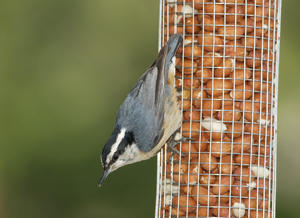Red-Breasted Nuthatch

A small, compact bird with a sharp expression accentuated by its long, pointed bill. Red-breasted Nuthatches have very short tails and almost no neck; the body is plump or barrel-chested, and the short wings are very broad.
Red-breasted Nuthatches are blue-gray birds with strongly patterned heads: a black cap and stripe through the eye broken up by a white stripe over the eye. The underparts are rich rusty-cinnamon, paler in females.
Red-breasted Nuthatches live mainly in coniferous forests of spruce, fir, pine, hemlock, larch, and western red cedar. During irruptive winters, nuthatches may use habitats such as orchards, scrub, parks, plantations, and shade trees.
- The Red-breasted Nuthatch collects resin globules from coniferous trees and plasters them around the entrance of its nest hole. It may carry the resin in its bill or on pieces of bark that it uses as an applicator. The male puts the resin primarily around the outside of the hole while the female puts it around the inside. The resin may help to keep out predators or competitors. The nuthatch avoids the resin by diving directly through the hole.
- During nest building, the Red-breasted Nuthatch is aggressive, chasing away other hole-nesting birds such as the House Wren, White-breasted Nuthatch, and Downy Woodpecker. A particularly feisty nuthatch may go after Yellow-rumped Warblers, House Finches, Violet-Green Swallows, and Cordilleran Flycatchers.
- Red-breasted Nuthatches migrate southward earlier than many irruptive species. They may begin in early July and may reach their southernmost point by September or October.
- Red-breasted Nuthatches sometimes steal nest-lining material from the nests of other birds, including Pygmy Nuthatches and Mountain Chickadees.
- The oldest known Red-breasted Nuthatch was 7 years, 6 months old.
Red-breasted Nuthatches are not usually found in the Conejo Valley. However, there have been a few recent local sightings this year!
Most of this information is from Cornell's All About Birds website.

